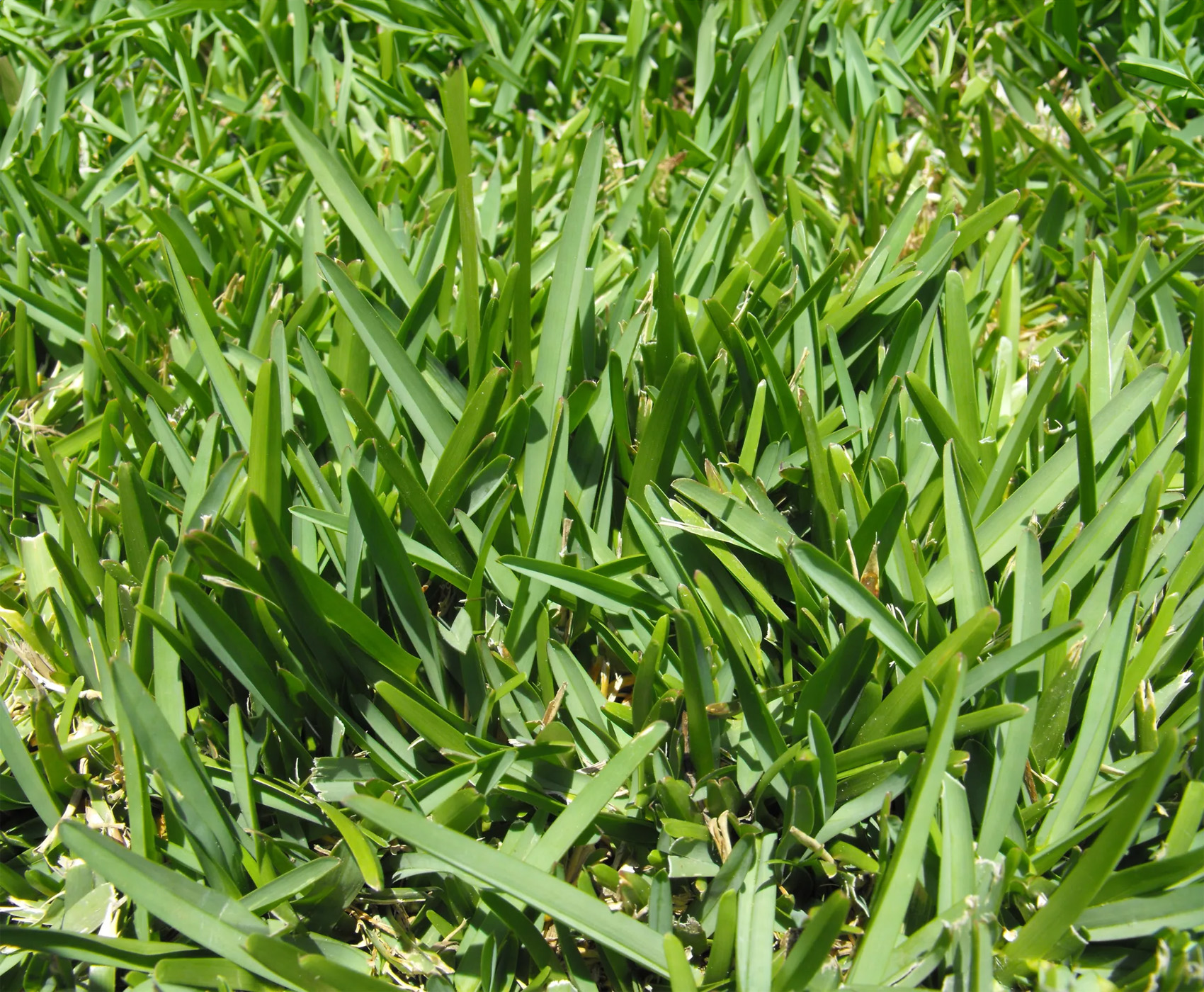Why Does Grass Grow In Clumps?
Grass grows in clumps for various reasons, including under and over-watering. Soil that’s too acidic or too alkaline can cause a variety of problems for your lawn, including clumpy grass areas. Soil also plays a significant factor. When you water your lawn, the grass may grow in clumps because the water can’t penetrate the soil quickly enough. Other causes of grass clumps include pests, improper maintenance, disease, poor lawn health, climate, and the type of grass you have.
Dealing with grass clumps is fairly easy once you know the cause.
- Aerating your lawn twice a year will help if the soil is dense or the lawn is compacted.
- Stick to a weekly watering schedule of about 1 inch per week, including rainfall, and make sure to water in the early morning.
- Check your lawn for pests and diseases and mow at the proper height for your grass species.
- Add fertilizer to keep your grass healthy and overseed to fill bare spots.
- Plant grass species not prone to growing in clumps.
Grass is an important part of our ecosystem and daily lives. Understanding how grass grows can help cultivate a beautiful lawn without random clumps or bare spots. Your lawn can be lush and healthy if it’s properly managed.
The Biology Of Grass And Why It Clumps
Why grass grows in clumps has much to do with its biology. Grass belongs to the Poaceae family, one of the most diversified plant families on Earth, encompassing more than 10,000 species. They’ve adapted to survive in various conditions, ranging from the frigid tundra to the scorching desert. Grasses are primarily characterized by their slender leaves, fibrous root systems, and unique seed-producing structures commonly referred to as “grains.'”
The structure of a grass plant consists of the blade (the part we typically think of as the grass itself), the crown (where growth occurs and new blades are produced), and the root system, which can be shallow or deep, depending on the species and environmental conditions.
One distinguishing characteristic of grass is how it reproduces and spreads. Most grass species can reproduce both vegetatively and sexually.
- Sexual reproduction occurs when grass flowers are pollinated, resulting in the formation of seeds. These seeds then spread through various means, such as wind, water, or animal activity, leading to the growth of new grass plants in different locations.
- Vegetative reproduction happens when the grass plant grows horizontally, either above or below the ground, through structures called stolons or rhizomes. This vegetative growth results in new grass plants genetically identical to the parent plant, creating a dense network of interconnected grass individuals. This method is particularly prevalent in many lawn grasses and contributes significantly to the thick carpet-like appearance of well-maintained lawns.
Grass species vary significantly in their growth patterns. Some, like Kentucky bluegrass or Bermuda grass, spread extensively through stolons or rhizomes, often forming a dense, uniform mat. Others, such as fescue or ryegrass, primarily grow in a more upright or ‘bunching’ pattern, resulting in the formation of distinct clumps.
What Is Clumped Grass?
Clumped Grass is a growth pattern where the grass seems to gather into distinct clusters or “clumps” rather than growing uniformly. This creates a bumpy or tufted landscape instead of a smooth, uniform carpet of grass.
Clump growth is not an abnormality or anomaly, it’s standard among many grass species. Certain species are termed ‘bunchgrasses’ due to their propensity to grow in clumps. These grasses, which include species such as ryegrass, fescue, and many native prairie grasses, predominantly expand through ’tillering’ – a process of vegetative reproduction where new blades of grass sprout from the base of the plant, creating a ‘bunch’ or ‘clump’ of grass blades.
The exciting thing about clump growth is that it’s not just a random occurrence but a pattern dictated by the grass’s genetics, environmental conditions, and sometimes human intervention. Multiple factors interplay in complex ways to create the tufted landscapes we call clumpy grass.
Because of how complicated clump grass is, it takes a combination of methods to prevent and fix clumped grass.
How To Manage Clumped Grass
Once you understand why grass grows in clumps, it becomes easier to deal with it. If you want to maintain a smooth, evenly green grass carpet, a few strategies can help.
Tips for Maintaining a Healthy Lawn with Clump-Forming Grasses
- Understanding Your Grass: Knowing the type of grass in your lawn is essential. Stay away from grasses prone to grow clumpy because of their genetics.
- Regular Watering: Regular, deep watering encourages grass to grow deeper roots and spread evenly. Shallow, frequent watering can promote clump growth.
- Fertilizing and Soil Health: Regularly adding compost or organic fertilizer helps improve soil health, ensuring optimal conditions for grass growth.
Strategies for Managing or Preventing Unwanted Clumps
- Proper Mowing: Regular mowing at the correct height can discourage clump formation. Cutting grass too short can stress it, causing it to clump as it regrows.
- Lawn Aeration: Aerating your lawn helps to alleviate soil compaction, which can encourage clumping. Aeration allows water, nutrients, and air to reach grass roots more effectively.
- Overseeding: If your grass clumps are due to patchy growth, overseeding can help. Adding new grass seeds to the lawn can encourage a more even grass spread. You can also pull up clumps and overseed in the bare areas.
The Role of Professional Lawn Care Services in Managing Clump Growth
- Professional Evaluation: If clump growth is a persistent issue in your lawn, consider consulting a professional lawn care service. They can evaluate your lawn’s conditions and provide tailored strategies for clump growth.
- Disease and Pest Control: Grass clumps can be caused by lawn pests or diseases. Professional services can help diagnose and treat these problems effectively.
Understanding the reasons behind clump growth and the tools to manage it puts you in a better position to care for your lawn. Whether you embrace the clumps or strive for carpet-like perfection, remember that both approaches can lead to a healthy, attractive lawn.
Factors Contributing to Clumped Grass Growth
The formation of grass clumps is a result of multiple intertwined factors, ranging from the intrinsic genetics of the grass species to external influences like environmental conditions and human intervention.
The Role of Genetics in Clump Formation
At the heart of clump growth lies the genetic programming of each grass species. While all grass species share a common botanical family, their genetic makeup varies widely, contributing to diverse growth patterns.
- Clump-Forming (Bunching) Species vs. Running (Spreading) Species: Some grass species, known as ‘bunchgrasses’ or ‘clump-forming grasses,’ are genetically programmed to grow in clumps. Examples include fescues and ryegrasses. These grasses primarily grow vertically, expanding through tillering, which results in new shoots growing from the plant’s base to form a clump. On the other hand, ‘running grasses,’ like Bermuda grass and Kentucky bluegrass, expand horizontally using rhizomes or stolons, leading to a more carpet-like spread.
- Growth Pattern Determined by Genetics: The clump or carpet growth pattern is not random but genetically determined. This growth style has evolved to help each species survive in its specific environment, whether the arid prairies or water-abundant wetlands.
Environmental Conditions
Environmental conditions significantly influence grass growth and can enhance or inhibit the clump growth pattern.
- Impact of Soil Conditions and Nutrient Availability: The type of soil, its nutrient content, and pH can affect grass growth. Certain soils may favor the development of clumps, especially if they are compacted or low in essential nutrients.
- Effect of Climate and Weather Patterns: Weather conditions such as temperature, rainfall, and sunlight can impact how grass grows. For instance, drought conditions can lead to more clumping as grass tries to conserve resources.
- The Role of Water Availability and Drainage: The soil moisture and drainage level can also influence clump growth. Poorly drained areas can lead to clumping as grasses strive to rise above the waterlogged soil.
Human Intervention
Human activities significantly affect grass growth, including promoting or inhibiting clump growth.
- Influence of Mowing and Lawn Care Practices: The frequency and height of mowing can impact grass growth. Overmowing can stress the grass, leading to clumping. Additionally, inadequate lawn care, including irregular watering and lack of aeration, can enhance clump formation.
- Role of Planting Techniques: How grass seeds are planted can affect their growth pattern. For example, broadcasting seeds randomly can lead to clump formation, whereas more systematic sowing might result in more uniform growth.
As discussed in subsequent sections, understanding these contributing factors can help us manage and control clump growth. It also reinforces the importance of clump growth in the broader ecological context, showcasing how grass species adapt to their environment.
The Ecological Significance of Clump Growth
Clumped grasses carry significant ecological implications. Clump growth helps grass species survive under various environmental conditions, contributes to soil conservation, enhances biodiversity, and plays a pivotal role in landscaping and ecological restoration projects.
Although we don’t like to see it in our lawns because it’s unattractive, clumped grass is integral to why grass survives.
Grass species that grow in clumps have evolved this growth pattern as a survival strategy. Clumping helps grasses conserve resources and ward off competition in harsh or competitive environments. The closely packed growth provides a microhabitat for the grass, conserving moisture and limiting the invasion of competing plant species.
Benefits of Clump Growth for Soil Conservation and Biodiversity
Clump-forming grasses play a vital role in soil conservation. Their growth pattern and extensive root systems help bind the soil, preventing erosion by wind or water. This characteristic makes clump-forming grasses beneficial in areas prone to soil degradation or erosion.
Clumps of grasses create a varied and complex habitat that can support many other organisms. From insects and spiders to larger creatures like birds and mammals, many organisms rely on grass clumps for food, shelter, or nesting sites, contributing to biodiversity.
The Role of Clump-Forming Grasses in Landscaping and Ecological Restoration Projects
From a landscaping perspective, clump-forming grasses can add texture and interest to a garden or lawn, providing a natural and aesthetic appeal. They can create borders, fill bare patches, or heighten specific garden designs. However, most people don’t want to see grass clumps in the middle of their lawns.
What Kind Of Grass Grows In Clumps?
The species of grass most commonly prone to growing in clumps are zoysia, bermuda, tall fescue, bluegrass, bahiagrass, centipede, and crabgrass.
If you have clumps of grass growing in your yard, identifying its species can be an important factor when dealing with it. Is it a type of weed or a type of grass? Once you know what type of grass it is, you can choose the best method to eliminate it.
Here is a list of grass commonly found throughout the United States that are prone to clumping:
Zoysia Grass
Zoysia grass is a popular choice for lawns and landscapes. It’s admired for its thick, carpet-like appearance, high drought tolerance, and minimal maintenance requirements. Native to East Asia, this warm-season grass has made a place for itself in many American lawns, particularly in the southern regions.
Despite its usual carpet-like spread, Zoysia grass can sometimes exhibit clump growth, primarily attributed to its impressive growth and reproduction mechanisms. Zoysia grass shows vertical and horizontal growth, unlike certain grass types that predominantly grow vertically, forming clumps or bunches. It spreads through stolons (above-ground stems) and rhizomes (below-ground stems), creating a dense, interconnected network of grass plants.
However, this spreading growth can become less uniform under certain conditions, resulting in clump formation.
- Factors such as uneven watering, soil compaction, irregular mowing, and nutrient deficiencies can stress the grass, leading it to conserve resources and grow more densely in specific areas, thus forming clumps.
- In areas of the lawn where the grass is thin or patchy, Zoysia grass might regrow in clumps after reseeding or natural reestablishment.
Understanding this potential for clump formation in Zoysia grass can help homeowners and landscapers better manage their lawns, keeping them lush, uniform, and healthy. Proper lawn care practices, including regular watering, mowing at the correct height, and maintaining soil health, can minimize clump growth in Zoysia lawns.
Bermuda Grass
Bermuda grass, scientifically known as Cynodon dactylon, is a warm-season turfgrass widely recognized for its resilience, aggressive growth, and ability to withstand high traffic. Originating from the African savanna, it’s become a common choice for lawns, golf courses, and athletic fields across many regions of the United States, particularly in the South.
- Bermuda grass is typically characterized by its sprawling growth habit, forming a dense, mat-like coverage.
- It propagates through stolons (above-ground stems) and rhizomes (below-ground stems), allowing it to spread rapidly and recover swiftly from damage.
Despite its usual spreading growth, Bermuda grass can sometimes form clumps. This clumping can be attributed to several factors.
- When under environmental stressors like irregular watering, nutrient deficiencies, or soil compaction, Bermuda grass may respond by growing more densely in certain areas, forming clumps.
- Insect damage or disease can also lead to patchy growth, with healthy sections growing in clumps amidst affected areas.
- Improper lawn care practices can contribute to clumping. Overmowing, for instance, can stress the grass, causing it to conserve resources and regrow in clumps.
- If Bermuda grass is reseeded in a lawn with patchy coverage, the new growth might emerge in clumps.
While Bermuda grass is typically known for its uniform, mat-like coverage, various factors can lead to clump formation. Understanding these factors is essential in managing Bermuda grass lawns effectively and maintaining their aesthetic and functional appeal.
Tall Fescue
Tall Fescue, or Festuca arundinacea, is a cool-season grass appreciated for its adaptability to various climates and soils and high tolerance to shade, heat, and drought. Native to Europe, this grass species has gained popularity across different regions in the United States, especially in the transition zone, which encompasses parts of the Southeast, Midwest, and Mid-Atlantic states.
Unlike the sprawling Bermuda and Zoysia grasses, tall Fescue naturally grows in clumps or bunches. This growth habit is deeply rooted in its biology and reproduction mechanisms.
- Tall Fescue expands mainly through ’tillering,’ a type of vegetative reproduction where new blades of grass, or tillers, sprout from the base of the plant. This results in forming a ‘bunch’ or ‘clump’ of grass blades instead of a spreading carpet of grass.
- The clump formation in Tall Fescue has evolved as a survival mechanism.
- Growing in clumps helps the grass conserve water and nutrients, protects it against pest invasions, and allows it to thrive in competitive environments.
- Fescue clumps have robust root systems that help bind the soil, reducing erosion and improving soil stability.
If adequately managed, tall Fescue can create a dense, uniform lawn despite its clumping nature.
Regular mowing at the correct height, ensuring uniform watering, and overseeding to fill in bare spots can help maintain an appealing, lush green lawn. Understanding Tall Fescue’s clump-forming growth habit allows homeowners and landscapers to cultivate this grass effectively, leveraging its resilience and adaptability for attractive, healthy lawns.
Bluegrass
Bluegrass, particularly Kentucky Bluegrass (Poa pratensis), is a cool-season grass cherished for its rich color and dense, carpet-like coverage. Originating in Europe and parts of Asia, it’s been successfully established in many regions of North America, particularly in the northern states and higher altitudes, where cool, humid conditions prevail.
Kentucky Bluegrass is known for its spreading growth habit. It propagates through rhizomes, underground stems extending horizontally, giving rise to new plants. This characteristic growth style typically results in a dense, uniform lawn akin to a lush green carpet.
However, under certain conditions, Kentucky Bluegrass may grow in clumps. The formation of these clumps is typically a response to environmental stresses or disruptions in growth patterns.
- In drought stress, nutrient deficiency, or poor soil conditions, the grass might grow more densely in certain areas, leading to clump formation.
- Irregular or overzealous mowing can stress the grass, encouraging denser growth or clumping.
- Lawn diseases, such as summer patches, can affect Kentucky Bluegrass, leading to sections of the lawn dying off and the healthy grass forming clumps.
- Inadequate watering can also lead to dry patches, with the remaining grass growing in clumps.
Understanding the circumstances under which Kentucky Bluegrass forms clumps can guide appropriate lawn care practices. Maintaining regular watering schedules, mowing at the correct height, providing balanced fertilization, and promptly addressing any signs of disease can help ensure a healthy, uniformly green lawn.
Bahiagrass
Bahiagrass, known scientifically as Paspalum notatum, is a warm-season turfgrass prized for its high drought and heat tolerance. It’s native to South America but has been successfully established in the Southeastern United States, particularly in Florida, where it’s often used for lawns, pastures, and roadsides due to its low maintenance requirements and resistance to pests and diseases.
Bahiagrass grows predominantly in a clump-forming pattern, a trait attributed to its biological growth mechanisms. Unlike grasses that spread via stolons or rhizomes, Bahiagrass primarily propagates through seeds, and its tillers (new grass shoots) grow upwards from a central crown. This leads to the development of distinct bunches or clumps of grass rather than a smooth, carpet-like growth.
The clumping growth pattern of Bahiagrass has evolutionary advantages.
- It allows the grass to efficiently conserve resources in environments where nutrients or water may be scarce.
- The dense clumps help ward off competition from other plant species, and their robust root systems contribute to soil stabilization, making Bahiagrass an excellent choice for erosion control.
Despite its clumping nature, Bahiagrass can form a reasonably uniform lawn with proper management. Regular mowing at the appropriate height, balanced fertilization, and effective weed control are critical to maintaining a healthy Bahiagrass lawn. Understanding its natural growth habit enables homeowners and landscapers to manage Bahiagrass effectively, leveraging its robustness and resilience for an attractive, hardy lawn.
Centipede Grass
Centipede Grass, known by its scientific name Eremochloa ophiuroides, is a warm-season grass known for its low maintenance requirements, slow growth rate, and excellent heat and drought tolerance. Originating from China and Southeast Asia, it has found a home in many lawns across the southern United States.
Centipede Grass is characterized by its spreading growth habit, often forming a thick, carpet-like lawn. It propagates through stolons, above-ground stems that grow horizontally, generating new plants as they spread across the surface.
Despite its usual sprawling growth, Centipede Grass may occasionally form clumps. Several factors can contribute to this clumping.
- Under environmental stresses such as inconsistent watering, soil compaction, or nutrient imbalances, Centipede Grass may conserve resources and grow more densely in specific areas, creating clumps.
- Improper lawn care practices like over-mowing or infrequent mowing can lead to stress, resulting in clump formation.
- Centipede Grass is susceptible to certain diseases and pests, which can lead to irregular growth patterns. For example, fungal infections can cause patchy damage, resulting in healthy grass forming clumps.
Although Centipede Grass typically provides a dense, uniform lawn, various conditions can lead to clump formation. A clear understanding of these conditions can guide effective lawn management strategies.
Regular watering, mowing at an appropriate height, and maintaining balanced soil nutrition are crucial to prevent clumping and ensure a lush, attractive lawn.
Crabgrass
Crabgrass, scientifically known as Digitaria, is a warm-season annual weed commonly encountered in lawns across North America. Originating from Europe, this weed is characterized by its resilience, aggressive growth, and ability to thrive in challenging conditions, making it a significant concern for lawn owners.
Crabgrass grows in a unique, clump-forming pattern, often radiating out from a central point, resembling the shape of a crab. It propagates primarily through seeds, producing thousands per plant annually. When these seeds germinate, they grow as individual plants, which expand outward in a clump or cluster, leading to thick patches of crabgrass that can out-compete desired grass species.
The clumping growth pattern of crabgrass provides several survival advantages.
- The dense growth can effectively shade the soil, preventing other plant species from establishing, and the thick clumps help the weed conserve water and nutrients.
- Crabgrass clumps have an expansive shallow root system that allows them to spread rapidly, quickly taking over disturbed or weak areas of a lawn.
Effective crabgrass management often involves prevention and early control, as it can be challenging to eradicate once clumps are formed.
Regular mowing at the correct height, consistent watering, and maintaining a healthy lawn can help prevent crabgrass infestation. Pre-emergent herbicides can also be used in early spring to prevent crabgrass seeds from germinating.
Recognizing the clump-forming growth habit of crabgrass can be beneficial in implementing timely and effective weed management strategies.
How Do You Fix Grass Clumps?
Managing clumps in a lawn requires a combination of preventive measures and direct interventions. Each method is aimed at promoting healthy, uniform grass growth.
Here’s a general outline of how to address and prevent grass clumps:
- Regular Mowing: Regular mowing is critical to preventing grass clumps. Make sure to mow at the right height for your grass type, and ensure your mower blades are sharp. Dull blades can cause tearing, which can lead to clumping.
- Aerate the Soil: Soil compaction can stress the grass, causing it to grow in clumps. Regular aeration helps loosen compacted soil and improve water and nutrient penetration, encouraging uniform grass growth.
- Balanced Fertilization: Nutrient imbalances can lead to clumping. A soil test can help identify nutrient deficiencies or pH imbalances. Based on the results, apply a balanced fertilizer that provides the necessary nutrients your lawn needs.
- Consistent Watering: Both over-watering and under-watering can cause grass clumps. Implement a consistent watering schedule of an inch per week, including rainfall, typically early in the morning.
- Overseeding: Overseeding can help achieve a more uniform lawn if clumps have already formed. Spread grass seeds over the existing lawn to fill in bare or thin spots and encourage denser growth.
- Address Lawn Diseases and Pests: Clumps can sometimes indicate underlying lawn diseases or pests. If you suspect a disease or pest issue, it’s best to consult with a professional for accurate diagnosis and treatment options.
- Control Weeds: Pre-emergent herbicides can be applied in early spring before the weed seeds germinate for clumping weed species like crabgrass. Post-emergent herbicides can be used for established weeds.
By understanding your lawn’s specific needs and promptly addressing issues, you can effectively prevent and manage clump formation, maintaining a lush, healthy, and uniform lawn.
Laying Sod
Laying sod is an excellent solution for lawns affected by clump growth, especially when combined with other measures. Sod essentially replaces the clumpy, uneven lawn with a fresh, uniform layer of grass.
Here’s a summary of the process and why it can be beneficial:
- Removal of Old Grass: The first step in laying sod is to remove the old, clumpy grass. This is typically done using a sod cutter to strip away the top layer of grass and a small amount of soil. This process helps to eliminate the clumpy grass and prepares the ground for the new sod.
- Soil Preparation: The next step is to prepare the soil after removing the old grass. This includes breaking up the soil with a rototiller, adding topsoil or compost if needed, and leveling the ground. This process creates a smooth, fertile bed for the sod to take root.
- Laying the Sod: The new sod is then laid out in a staggered pattern, much like brickwork, to avoid creating seams. The sod should be pressed down firmly to ensure good contact with the soil.
- Watering and Maintenance: After the sod is laid, it’s essential to water it regularly for the first few weeks until it establishes. The sod should not be mowed until the roots firmly take hold in the soil, typically after 2-3 weeks.
Laying sod provides an instant, uniform lawn, effectively eliminating the problem of grass growing in clumps.
As the sod is typically grown under ideal conditions, it tends to be healthy and resilient, capable of resisting diseases, pests, and weed invasions better than a weak, clumpy lawn. However, continuing good lawn care practices after laying sod is essential. This includes regular mowing, proper watering, and balanced fertilization to maintain a healthy, clump-free lawn.
Why Does Grass Grow In Clumps?
Grass growing in clumps is common in many grass species and can be attributed to biological traits and environmental factors.
- Biology of Grass: Some grass species naturally grow in clumps due to their biological structure and reproductive mechanisms. Grasses like Tall Fescue or Bahiagrass propagate primarily through seeds or “tillering.” This results in dense bunches or clumps of grass blades rather than a sprawling carpet of grass.
- Survival Mechanisms: The clumping growth pattern is often an adaptive response to challenging environmental conditions. Clumps enable grass to conserve water and nutrients, provide protection against pest invasions, and allow the grass to compete more effectively with other plant species in the same environment.
- Environmental Stress: Clumping can also occur due to environmental stresses such as irregular watering, poor soil conditions, or nutrient deficiencies. When stressed, grass grows more densely in certain areas, forming clumps.
- Lawn Care Practices: Improper lawn care practices like over-mowing, infrequent mowing, or uneven watering can lead to stress. This encourages denser growth or clumping. Similarly, certain lawn diseases or pest infestations can cause irregular growth patterns, resulting in clump formation.
- Weed Infestation: Certain weeds, such as crabgrass, are known for their clump-forming growth pattern. Their presence can give a lawn a clumpy appearance.
Understanding why grass grows in clumps can help homeowners manage their lawns more effectively. Employing appropriate care and maintenance strategies will ensure a healthy, uniform lawn.
Summary: Why Does Grass Grow In Clumps?
Grass may grow in clumps for a variety of reasons, including under and over-watering. Soil that’s too acidic or too alkaline can cause a variety of problems for your lawn, including clumpy grass areas. Soil also plays a significant factor. When you water your lawn, the grass may grow in clumps because the water can’t penetrate the soil quickly enough. Other causes of grass clumps include pests, improper maintenance, disease, poor lawn health, climate, and the type of grass you have.
Dealing with grass clumps is pretty easy once you know the cause.
- Aerating your lawn twice a year will help if the soil is dense or the lawn is compacted.
- Stick to a weekly watering schedule of about 1 inch per week, including rainfall, and make sure to water in the early morning.
- Check your lawn for pests and diseases and mow at the proper height for your grass species.
- Add fertilizer to keep your grass healthy and overseed to fill bare spots.
- Plant grass species not prone to growing in clumps.
Grass is an essential part of our ecosystem and daily lives. Understanding how grass grows can help cultivate a beautiful lawn without random clumps or bare spots. Your lawn can be lush and healthy if it’s properly managed.
If you have any questions or comments about why and how grass can grow in clumps, email any time.























